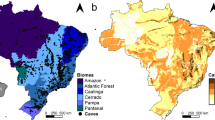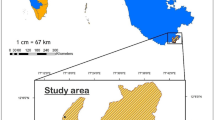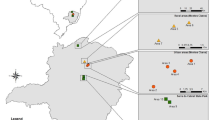Abstract
Nest complexes of Formica ants were studied in the Darwin Nature Reserve, in Rybinsk Reservoir basin (Vologda and Yaroslavl Provinces). A strong negative influence of wild boars was demonstrated based on the data of 1997–2012. Boars damage ant nests, which may lead to their complete destruction. The adverse influence of boars is intensified in the years with high water levels in the reservoir, when the boars cannot feed in the temporary inundation zone and thus increase their impact on the forest and ant nests. Due to the long succession of highwater years since 2004 and the resulting strong impact of wild boars, the number and size of ant nests drastically decreased, and the abundance and biomass of Formica ants in forest ecosystems were reduced.
Similar content being viewed by others
References
Alekseev, V.A., “The 40 Years of Study of the Terrestrial Invertebrate Fauna in the Darwin Reserve,” in Fauna and Ecology of Invertebrates in the Nature Reserves of the Russian Federation: Collected Papers (Moscow, 1986), pp. 4–20 [in Russian].
Arens, L.E., “The Insect Fauna of the Lower Forest Layers,” in Proceedings of the Darwin Reserve, Issue 10 (Vologda, 1971), pp. 191–229 [in Russian].
Arnoldi, K.V., Grimalsky, V.I., Demchenko, A.V., et al., “The Ecological Studies of Ants,” in Ants and Forest Protection: Proceedings of All-Union Myrmecological Symposium (Tartu, 1979), pp. 156–171 [in Russian].
Dyachenko, N.G., “Species Composition of Formica Ants in Bialowieza Forest and Their Specific Ecological Traits,” Parki Narod. Rezerw. Przyrody Bialowieza 18 (18), 81–90 (1999).
Efremov, A.A., “The Effects of Damage and Fencing on the Formica lugubris Nest Size,” in Ants and Forest Protection: Proceedings. of XIV All-Russian Myrmecological Symposium (KMK Sci. Press, Moscow, 2013), pp. 216–221.
Filonov, K.P. and Nukhimovskaya, Yu.D., “Management of the Dynamics of Natural Components in Reserves,” in Ecology of the Protected Territories in Russia (Yanus-K, Moscow, 1997), pp. 365–448 [in Russian].
Rybnikova, I.A., “Fauna and Biotopic Distribution of Ants in the Darwin Reserve,” in Proceedings of the Darwin Reserve, Issue 16 (Cherepovets, 2006), pp. 216–221 [in Russian].
Rybnikova, I.A. and Kuznetsov, A.V., “Ant Communities on the Islands of Rybinsk Reservoir,” in Ants and Forest Protection: Proceedings of X All-Russian Myrmecological Symposium (Moscow, 1998), pp. 134–137.
Zakharov, A.A., “A Technique for Surveying the Nest Complexes of Red Wood Ants,” in Ants and Forest Protection: Proceedings of IV All-Union Myrmecological Symposium (Moscow, 1971), pp. 89–93.
Zakharov, A.A., Ant, Family, Colony (Nauka, Moscow, 1979) [in Russian].
Author information
Authors and Affiliations
Corresponding author
Additional information
Original Russian Text © I.A. Rybnikova, A.V. Kuznetsov, 2015, published in Zoologicheskii Zhurnal, 2015, Vol. 94, No. 10, pp. 1125–1131.
Rights and permissions
About this article
Cite this article
Rybnikova, I.A., Kuznetsov, A.V. Complexes of Formica s. str. nests in the Darwin Nature Reserve and causes of their degradation. Entmol. Rev. 95, 947–952 (2015). https://doi.org/10.1134/S0013873815080023
Received:
Published:
Issue Date:
DOI: https://doi.org/10.1134/S0013873815080023




